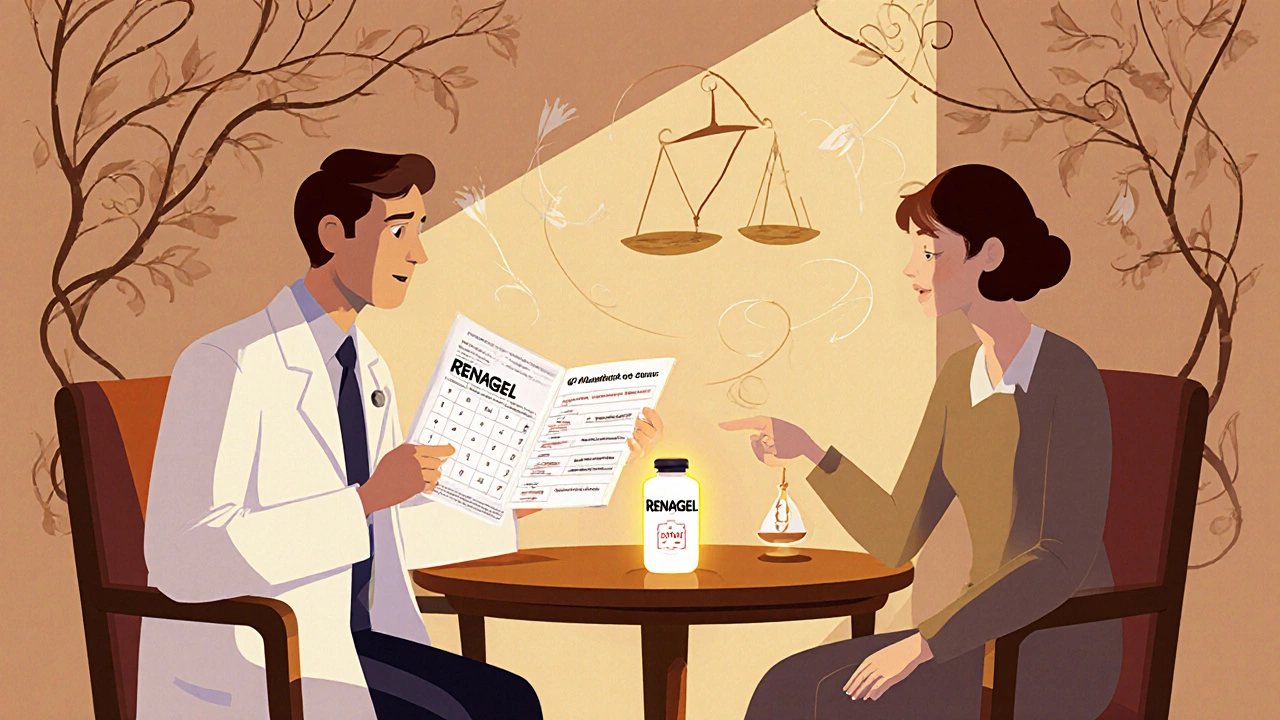Renagel (Sevelamer) vs. Other Phosphate Binders: In‑Depth Comparison

Oct, 22 2025
Living with chronic kidney disease (CKD) means juggling a lot of numbers - blood pressure, eGFR, and especially phosphate levels. Too much phosphate can speed up vascular calcification and bone disease, so doctors prescribe phosphate binders to keep the serum phosphate in check. Renagel (the brand name for sevelamer) is one of the most talked‑about binders, but it’s not the only option on the market. This guide walks you through how Renagel stacks up against the most common alternatives, so you can understand the trade‑offs and talk confidently with your nephrologist.
What is Renagel (Sevelamer) and Why Do Patients Use It?
Renagel is a non‑calcium, polymer‑based phosphate binder whose active ingredient is sevelamer hydrochloride. It works by binding dietary phosphate in the gut, preventing absorption and thereby lowering serum phosphate levels. The drug is approved for patients on dialysis and for those with stage 3-5 CKD not yet on dialysis. Because it contains no calcium, Renagel avoids adding extra calcium load - a key concern for patients prone to vascular calcification.
How Do Other Phosphate Binders Work?
Phosphate binders fall into three broad categories:
- Calcium‑based binders (e.g., calcium acetate, calcium carbonate) - bind phosphate but also contribute calcium, which can help bone health but may increase calcification risk.
- Ceramic binders (e.g., lanthanum carbonate) - use inert metal oxides that bind phosphate with minimal calcium.
- Iron‑based binders (e.g., sucroferric oxyhydroxide, ferric citrate) - use iron to latch onto phosphate and may improve iron stores.
Each class has its own pros and cons, and the right choice depends on your lab numbers, pill tolerance, and cost considerations.
Key Decision Criteria When Picking a Binder
Before we dive into side‑by‑side numbers, here are the five factors most clinicians weigh:
- Phosphate‑lowering efficacy - how much the drug can drop serum phosphate per dose.
- Calcium load - whether the binder adds extra calcium to the diet.
- Pill burden - total number of tablets needed daily.
- Side‑effect profile - GI upset, metabolic changes, or other adverse events.
- Cost and insurance coverage - out‑of‑pocket expense for patients.
Now let’s see how Renagel measures up against the most frequently prescribed alternatives.
Comparison Table: Renagel vs. Leading Alternatives
| Binder | Mechanism | Typical Daily Dose | Pill Burden (≈ tablets/day) | Calcium Load | Common Side Effects | Average Monthly Cost (AUD) |
|---|---|---|---|---|---|---|
| Renagel (Sevelamer) | Polymer binds phosphate via ionic exchange | 4.8-9.6 g (800‑1600 mg tablets) | 6‑12 | None | Constipation, nausea, metabolic acidosis (rare) | ~$150‑$200 |
| Calcium acetate | Calcium ion binds phosphate | 2.6-5.2 g | 3‑6 | High (adds 400‑800 mg Ca/day) | Hypercalcemia, constipation | ~$30‑$60 |
| Lanthanum carbonate | Lanthanum oxide binds phosphate | 1.5‑3.0 g | 2‑4 | None | Diarrhea, abdominal pain | ~$120‑$170 |
| Sucroferric oxyhydroxide | Iron‑based polymer binds phosphate | 1‑2 g | 1‑2 | None | Dark stools, mild GI upset | ~$130‑$180 |
| Ferric citrate | Ferric iron chelates phosphate | \n2‑4 g | 3‑5 | None | Diarrhea, iron overload (rare) | ~$100‑$150 |
| Magnesium carbonate | Magnesium ion binds phosphate | 2‑4 g | 2‑4 | Moderate (adds Mg²⁺) | Diarrhea, hypermagnesemia (rare) | ~$20‑$40 |
Deep Dive: How Renagel Handles the Five Decision Criteria
Efficacy - Clinical trials (e.g., the DCOR study) showed sevelamer can lower serum phosphate by 0.5‑0.8 mg/dL compared with placebo. It’s comparable to lanthanum and iron‑based agents, but slightly less potent than calcium acetate when high calcium intake isn’t a concern.
Calcium load - This is Renagel’s standout feature. Because it contains zero calcium, it’s the go‑to for patients with existing vascular calcification or high serum calcium. For those already on calcium‑based binders, switching to Renagel can reduce calcium load by up to 800 mg per day.
Pill burden - Unfortunately, Renagel is the most pill‑heavy. The 800 mg tablet size forces patients to swallow six to twelve pills daily. This can be a deal‑breaker for anyone with dysphagia or limited dexterity.
Side‑effects - The most common complaints are constipation and nausea. Some patients develop metabolic acidosis because sevelamer is a chloride‑based polymer. In contrast, iron‑based binders often cause dark stools, which are harmless but can alarm patients.
Cost - In Australia, Renagel sits near the top of the price range, especially after the 2023 PBS subsidy reduction. Calcium acetate remains the cheapest, while lanthanum and iron‑based options fall in the mid‑range.
When Renagel Is the Right Choice
If your recent labs show:
- Serum phosphate > 5.5 mg/dL despite calcium‑based therapy,
- Serum calcium at the upper normal limit (≥ 2.55 mmol/L),
- Evidence of vascular calcification on imaging,
…your nephrologist may suggest swapping to Renagel. The drug’s zero‑calcium profile helps break the calcium‑phosphate cycle that drives calcification. It’s also useful when patients have refractory hyperphosphatemia that isn’t fully controlled by calcium acetate alone.
When Alternatives Might Be Better
Consider the following scenarios:
- High pill burden - If swallowing more than eight tablets a day is unrealistic, lanthanum carbonate (2‑4 pills) or sucroferric oxyhydroxide (1‑2 pills) are attractive.
- Concurrent iron deficiency - Ferric citrate can kill two birds with one stone, lowering phosphate while boosting iron stores.
- Budget constraints - Calcium acetate is the most affordable; many PBS schemes still cover it fully.
- Gastro‑intestinal intolerance - Patients who develop severe constipation on Renagel may find magnesium carbonate or lanthanum easier on the gut.

Practical Tips for Switching Between Binders
- Check latest phosphate, calcium, and iron labs before the change.
- Start the new binder at a low dose; titrate every 1‑2 weeks based on labs.
- Maintain consistent dietary phosphate intake to avoid confounding results.
- Monitor for new GI symptoms - especially constipation or diarrhea.
- Document any change in medication cost or insurance coverage.
Most importantly, any switch should be done under a nephrologist’s supervision. Abruptly stopping a binder can cause a rapid phosphate rebound, which is dangerous.
Frequently Asked Questions
Can I take Renagel and calcium supplements together?
Yes, but be mindful of total calcium intake. Renagel itself adds no calcium, so you can safely supplement with 500‑600 mg elemental calcium if your diet is low, as long as serum calcium stays within the target range.
Why does Renagel sometimes cause metabolic acidosis?
Sevelamer hydrochloride releases chloride when it binds phosphate. In some patients, the extra chloride mildly lowers serum bicarbonate, leading to a mild metabolic acidosis. If this becomes clinically significant, doctors may switch to the sevelamer carbonate formulation, which is less likely to cause acidosis.
How quickly does phosphate level drop after starting Renagel?
Most patients see a measurable decrease (0.3‑0.5 mg/dL) within 1‑2 weeks. Full steady‑state effect is usually reached after 4‑6 weeks of consistent dosing.
Is Renagel safe for peritoneal dialysis patients?
Yes, sevelamer is approved for both hemodialysis and peritoneal dialysis. The dosing schedule may differ slightly because peritoneal patients often have different dietary phosphate loads.
What should I do if I’m experiencing constipation on Renagel?
Increase dietary fiber, hydrate well, and discuss a stool softener with your doctor. Sometimes splitting the dose throughout the day or adding a low‑dose magnesium supplement helps.
Bottom Line
Renagel (sevelamer) shines when you need a potent phosphate binder without adding calcium - a common scenario for patients with advanced CKD and vascular calcification. Its main drawbacks are the high pill count and price. Alternatives like lanthanum carbonate, sucroferric oxyhydroxide, or calcium acetate each bring a different balance of efficacy, convenience, side‑effects, and cost. The best choice is highly individual, so use the comparison table, weigh the five decision criteria, and have an open chat with your kidney care team.
Next Steps for Readers
- Print or screenshot the comparison table to bring to your next appointment.
- Ask your nephrologist to review your recent labs (phosphate, calcium, iron) and discuss which binder aligns with your goals.
- If cost is a hurdle, request a PBS subsidy review or explore patient assistance programs offered by manufacturers.
- Track any side‑effects in a simple diary - this helps your doctor fine‑tune the dose.
Armed with these facts, you can move from guesswork to a clear, evidence‑based plan for managing phosphate levels.
